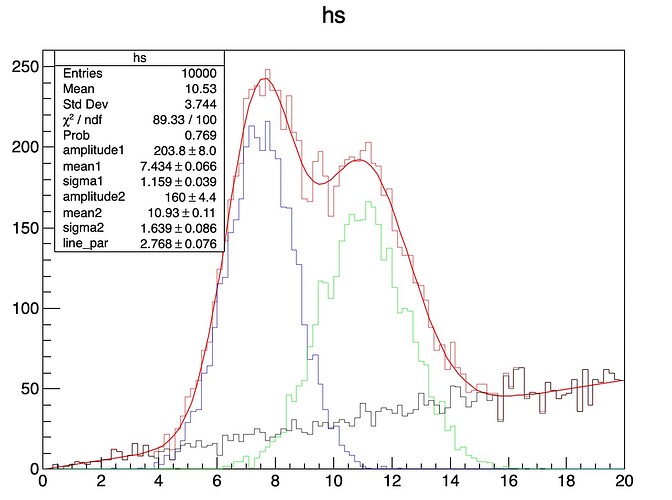#include <TStyle.h>
#include <TH2.h>
#include <TSystem.h>
#include <TChain.h>
#include <TCanvas.h>
#include <TCut.h>
#include <TString.h>
#include <TGraph.h>
#include <TF1.h>
#include <TMath.h>
#include <iostream>
#include <TFile.h>
#include <TH1.h>
# include<TPaveStats.h>
double function1(double *x, double *p){
return p[0]*TMath::Gaus(x[0],p[1],p[2])+p[3]*TMath::Gaus(x[0],p[4],p[5])+x[0]*p[6];
}
void fit_script(){
Int_t nbins=110;
Double_t xmin=0;
Double_t xmax=20;
Double_t mean1=7.5;
Double_t sigma1=1.2;
Double_t mean2=11;
Double_t sigma2=1.5;
TCanvas *c1 = new TCanvas("canvas", "Histograms", 800, 600);
gStyle->SetOptStat(1);
gStyle->SetOptFit(1111);
gStyle->SetStatY(0.9);
gStyle->SetStatX(0.35);
gStyle->SetStatW(0.13);
gStyle->SetStatH(0.11);
char formula1[100];
sprintf(formula1, "TMath::Gaus(x,%f,%f)", mean1, sigma1);
char formula2[100];
sprintf(formula2, "TMath::Gaus(x,%f,%f)", mean2, sigma2);
// 创建TF1对象
TF1 *gaus1 = new TF1("gaus1", formula1, xmin, xmax);
TF1 *gaus2 = new TF1("gaus2", formula2, xmin, xmax);
TF1 *bg1 = new TF1("bg1","8*x",xmin,xmax);
TF1* g1 = new TF1("g1","gaus",0,10);
TF1* g2 = new TF1("g2","gaus",9,14);
TF1 *b3 = new TF1("b3","x*[0]",16,20);
TF1* total = new TF1("mstotal",function1,0,20,7);
TH1D* gauss1=new TH1D("gauss1","gauss1",nbins,xmin,xmax);
TH1D* gauss2=new TH1D("gauss2","gauss2",nbins,xmin,xmax);
TH1D* bg=new TH1D("bg","bg",nbins,xmin,xmax);
TH1D* hs=new TH1D("hs","hs",nbins,xmin,xmax);
gauss1->FillRandom("gaus1", 3500);
gauss2->FillRandom("gaus2", 3300);
bg->FillRandom("bg1", 3200);
TList *list = new TList;
list->Add(gauss1);
list->Add(gauss2);
list->Add(bg);
hs->Merge(list);
hs->SetLineColor(kRed);
gauss1->SetLineColor(kBlue);
gauss2->SetLineColor(kGreen);
bg->SetLineColor(kBlack);
hs->Draw();
gauss1->Draw("same");
gauss2->Draw("same");
bg->Draw("same");
Double_t par[7];
// Fit each function
hs->Fit(g1,"R0");
hs->Fit(g2,"R0+");
hs->Fit(b3,"R0+");
g1->GetParameters(&par[0]);
g2->GetParameters(&par[3]);
b3->GetParameters(&par[6]);
// Use the parameters on the sum
total->SetParameters(par);
total-> SetParName(0, "amplitude1");
total-> SetParName(1, "mean1");
total-> SetParName(2, "sigma1");
total-> SetParName(3, "amplitude2");
total-> SetParName(4, "mean2");
total-> SetParName(5, "sigma2");
total-> SetParName(6, "line_par");
hs->Fit(total,"R+");
c1->Update();
}
which couldn’t display all the fit parameter,but some gaussian parameters?
